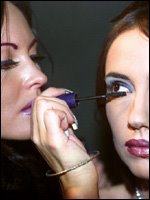Monday, October 30, 2006
Aim High

On a lighter note (finally) ...
Shout out to Idolator, the new music industry blog in the Gawker empire. They have lots of industry goodness (and badness) including the on-going tribute to public access music videos.
Oh the energy, oh the enthusiasm. Are these on someone's reel?
Greatest Public access videos
Part Two
Part Three
Part Five
Labels: music video, video link
Friday, October 27, 2006
Or you'll sink like a stone
 The Chairman of EMI, one of the last five (or is it three? two?) major labels, says that the CD is dead. This realization may be a bit late, but at least he, and the other majors, are finally getting it. Maybe he read about all the Tower Record stores closing in “Ye Olde Newsprinte”
The Chairman of EMI, one of the last five (or is it three? two?) major labels, says that the CD is dead. This realization may be a bit late, but at least he, and the other majors, are finally getting it. Maybe he read about all the Tower Record stores closing in “Ye Olde Newsprinte”Labels are branching out and trying to make money anyway they can. Sometimes it works (ring-tones) and other times not so much (value added CDs, Janet Jackson). Record labels are an industry rooted in the 1950s and for years, they have been trying to put the genie of technology back into the bottle with poor results (RIAA). It seems like they have finally turned the corner and are efforting to find a new path that doesn’t lead to Bankruptcyville.
When iTunes started selling videos – everyone in the MV world was excited that some of that cash would start to trickle back down to us peons. Have you got your check yet?
Selling videos on-line may never work as a way for directors to get money. The whole structure of the contracts directors sign with labels would have to change and THEN they would have to make their way through the “convoluted” accounting system to actually receive royalties or residuals. Ask the old Motown artists how that record label accounting works. The Four Tops are still waiting on their checks, too.
My point is, don’t count on the old system to provide the new answers.
There will always be music. But there may not always be record labels. Is that bad news? Not really, it just means that things will be different. The hardship and confusion for folks thinking that things will be as they have been may create more opportunity out there for young directors.
Just like there was more “opportunity” for cheap castles and downtown Parisian real estate after the Black Plague swept through. Assuming of course you survived.

Labels: baby director, death, insider, music video
Sunday, October 22, 2006
The Ceiling
 Music videos are fun, but I don’t know of anyone who got into video directing just to direct videos. Like the lame but attractive “comics” that crowd open mic night at the Comedy Store on Sunset because they see Seinfeld Dollar$ in their future, video directors usually want to also make money, direct features and get laid.
Music videos are fun, but I don’t know of anyone who got into video directing just to direct videos. Like the lame but attractive “comics” that crowd open mic night at the Comedy Store on Sunset because they see Seinfeld Dollar$ in their future, video directors usually want to also make money, direct features and get laid.That is the way the world works, college basketball is a stepping-stone to the NBA and low-budget music video are the path to “bigger” successes.
Wannabe feature directors borrow money from Grandma and max out their credit cards to shoot indie movies and weird shorts that play at strange film festivals. They are not doing this because they wanna win at Slamdance, they are doing it because the want to be Scorsese or Coppola. Without the possible future “reward” of a big contract from Warners or Paramount – would anyone spend a whole year making an indie movie only to spend another year trying to get it distributed?
That leads me to …
Music video budgets are down, way down. Especially if a director is white, likes rock music and dismissively spits out the words “Rap videos” like he is saying “Kiddie porn” – he may never see a budget over $150k in his life. Nothing wrong with directing rock clips – but it is just a very crowded field without the prospect bigger-budgeted paydays to ease the way.
Directing micro-budgeted indie music videos is a lot of work with very little financial reward. That's okay if there is a pay-off waiting farther down the line. If a young director does indie and cheap well, there used to be the juicy carrot of a big budget Aerosmith or Chilipepper video way out on the end of the stick. Today, not only is the stick longer, there are more people fighting over it and I doubt there is even a carrot out there when we finally make it.
If a young video director does well, he hopes to catch the eye of a film studio. Fincher did it and so did Bay, but when labels are spending under $200k on artists with major track records – how can a director get noticed by Hollywood?
I wonder if there is not a ceiling developing. The budgets are small and it is hard to make a decent living on 10% of $80,000 when you may only get a handful of those jobs in a year. In the past, directors might be willing to play in the minor leagues if there was a shot at the big-time. The problem is, the "big-time" now has the Chilipeppers shooting their clips on HD and spending $120k. Is there still a big time?
Without the financial pay-off of graduating to the music video big leagues as a reward – who will want to direct the small stuff? For now, it seems like everyone does. Today, the fight over tiny budgeted gigs is still fierce. There are still many willing to do the audition job, but I believe that word is getting out. Visual minded people can make more of a living as web-designers or post-production types than they can as a music video director (the top ten guys in the industry excepted and you are not one of them, since you have time to read this).

Without the NBA – are high-school kids desperate to play college basketball? Without sit-com dollars, are actor types eager to slog through embarassing stand-up open mic nights? Without the Yankees and Dodgers handing out million dollar contracts, do baseball playes head to the minor leagues to ride the Bull Durham bus between Tuscaloosa and Sweetwater? Without “Big Pimpin” or “November Rain” level paydays, how long will there be directors willing to act like they don’t see the ceiling above their heads?
October 24 Addendum: This post is NOT about a creative ceiling. I have gotten some feedback along the lines of "People out there are doing great work." Of course they are. The thoughts above are about the financial/career ceiling that seems to be hovering above the music video industry - seen but unspoken about like a drunken uncle passed out by the TV at Thanksgiving. I think that the lack of a sustainable career will eventually drive talented people into other avenues of expression where they can pay their bills and feed their children - or cause them to never consider music video directing as an option in the first place. Like most things, being good at music video directing takes commitment and I wonder how many folks can/will stay commited to the be-ceilinged reality of the industry once they tire of having three room-mates, a car with no A/C and eating Top Ramen four times per week.
Labels: baby director, death, insider, music video
Friday, October 20, 2006
Co-directors

Co-directing. There is nothing a director likes less than hearing that the artist (or the manager, or the choreographer, or the post-house) wants co-directing credit. The director can fight this, but that is rarely smart. If the director wants to get paid, he usually has to buckle under and smile as the artist puts his/her name on the video alongside the actual director.
Who cares? Well, mostly the director cares – but not many other folks will even notice. Many videos are seen almost exclusively on-line and most internet outlets do not display the director credit at all (it seems). If the artist is a white guy with a guitar – your video will be on Fuse and they don’t list the director on screen either. The director credit is something very few people even realize exists, but it is one of the last bastions of the director’s dignity.
Hype has to share credit with Busta. Dave Meyers has to share with Missy. Even Floria has to share with Christina. Such is the way of the world. Even if the artist does little more than pick out clothes and show up to “help cast” the sexy dancers – they believe they ARE co-directing, because artists are children.
But, it runs much deeper than that. Almost all jobs (at least in the large label/budget world that I am familiar with) require thousands of creative compromises to integrate what someone from the label wants. I’m not talking, “We have to lose the helicopter shot for budgetary reasons” – I mean the label people saying, “What about if …” That is where things get scary.
I am not a big “auteur theory” guy in general, but working in music videos makes it crystal clear how much the input of others effects the finished video. Not because the director needs creative help, but because the label wants the things they want, or simply because some VP wants to justify their job by getting their fingerprints all over the edit.
I have seen the label take a super-simple concept and add in driving footage and a complex club scene and then complain why the budget went up.
I have seen a “brand manager” step in to place their young, female relative in a prominent role, only to complain that the relative was dressed too sexily. Duh. This also happened another time with the label exec putting their dog in the video, where the dog made zero sense. At least the dog being under-dressed was not an issue.

One job had a group of singers where the “issue” all throughout the development of the concept was – “make them look like three equal members.” That was the mantra – no lead singer, but three equals. We re-worked the storyboard and treatment many times to be sure the screen time would be split three ways. Then, on the set, one of the very top people at the label steps in and places one of the girls front and center. The guy is literally blocking the shots to be sure that there is way more of the one girl in all the close-ups. Mr. Big was clearly very, uh, familiar with the young and attractive girl he was pushing to the fore-front. This annoyed the director, but not nearly as much as it annoyed the other two girls in the group. I would assume that is why we spent so much time making the girls feel like equals ahead of time, because the other lower-level label types knew what would happen on the set.
One of the biggest places where the label and manager types step in is in the editorial process. They will go in and frame-fuck the edit, watching over the director and editor’s shoulder and suggesting change after change and then threaten to not pay because the completed video missed their TRL deadline.
One of the biggest “victims” of the frame-fucking (other than the ego of the editor/director) is the concept or narrative of the video. Countless times, we have worked with artists on a trippy conceptual setting or even an A-to-B-to-C narrative in pre-pro and on the day of the shoot – only to have much of it cut out in the edit in favor of more (and more) close-ups of the singer. I understand wanting to see the singer, but labels/artists often insist on a big, complicated story before the edit – but then when it comes time to put it on TV – they sacrifice the narrative footage they shot (and paid to shoot) for more "product" shots of the artist’s face. If you see a narrative video and it makes no sense – it may not be the director’s fault – his “co-directors” may have cut out all the scenes that made things make sense.
How does this work on the $10k-50k videos? Does the label “co-direct” on the smaller jobs as well? Any thoughts?
Labels: antville, baby director, music video
Tuesday, October 17, 2006
Execution


Christina Aguilera "Hurt" and Jay-Z "Show Me What You Got"
These two videos are linked in my mind, perhaps because they came out on back to back days - but I think there is also something deeper tying them together.
These two videos are both prime examples of "execution" clips. Nothing new or different here, just two established artists doing what they do well. No ground is broken, but sometimes that is okay. Nobody goes to see the Rolling Stones in concert to hear the new stuff, we all wanna hear "Satisfaction" and "Wild Horses." Both the Christina and the Hova clips fall into the category of "if it ain't broke - don't fix it."
Update: The Sony website has a good quality version of the "Hurt" video here.
Conceptually, this vintage circus look is cool and is just the kind of thing that Floria could take in a cool/weird direction. Did she? Well, with Christina as her listed co-director, the visuals always stay between the lines. The look was all sepia and pretty - clearly focused on making Christina look Beautiful. Even if she is hanging with the sideshow freaks, Christina is never a freak, she’s pretty as can be. To my eyes, the period circus was handled much better by Bryan Barber in Outkast's "Whole World" clip.
Christina's "Hurt" feels like a thematic rehash of "Beautiful" - but this is the new faux-deep song every thirteen year old girl and gay guy cranks up on their headphones when the world does them wrong and they wanna just curl up with their feelings for a while (with me it usually "Dirty Deeds" or the Starlight Express soundtrack). Mission accomplished, I guess. This is probably exactly the video they were going for and they got it.

Now on to a better clip (to me) and in some ways a bigger disappointment, Jay Z's “Show Me.” The director, F. Gary Gray, was one of the absolute titans of the music video field before he left to direct big features like “The Italian Job.” Gary was the first (as I recall) “star” director where the artists and labels wanted him first and then the concept came later. Gary has been out of music videos for 6+ years, but now he is back with the biggest name in the rap game.
The clip has cars, boats and a party at a house – essentially a Ca$h Money video with a bigger budget and a talented director. The video is fun and the million dollar budget is all on the screen, unlike some recent Hype clips where if you watch closely you can see the “director” running out the back of the soundstage with a suitcase full of the label’s cash.
This video is good, but I was hoping for great from Mr. Gray. That being said, the film-making is flawless. The angles are sharp, the cars and the people look like movie stars and the locations in Europe look tremendous. The boxes and strips edit technique also worked for me – adding to the rhythm of it all. Jay-Z went outside the box with “99 Problems” but now he is right back inside the box – but at least he looks damn good doing it. It is all in the execution.
To watch Jay-Z you have to register at the IDJ site (thanks Video Static) or settle for grainy Youtube.
Post-script - the Village Voice has noted that some bigger budgeted videos are getting made. I don't think that all their examples actually are big-budgeted, but at least they get paid to write so they must know something.
Labels: media, music video, review, video link
Saturday, October 14, 2006
Representing
 A rep is a director’s best friend (oops, don’t sleep with her). The rep acts as the sales agent – tracking what projects are upcoming and making contact with labels and independent commissioners to be sure their stable of directors gets work.
A rep is a director’s best friend (oops, don’t sleep with her). The rep acts as the sales agent – tracking what projects are upcoming and making contact with labels and independent commissioners to be sure their stable of directors gets work.The rep will often also help with the concept/treatment for the job – assisting the director in getting what she thinks the labels wants on paper. The rep will also (hopefully) guide the director towards which jobs will help build their career and which jobs are wild goose chases or destined to birth videos too lame to ever end up on their reel. The rep is a powerful force but …
Most directors still get the majority of their work through their own, personal contacts. Baby directors often fantasize about the day they get an established rep and then all their problems will be over. That, however, is just a fantasy. Reps are vital, but at the same time they can only do so much.
If the label wants a trippy, conceptual video and a director has only straight ahead performance stuff on their reel, they are likely to be out of luck. Even if the rep gets the director in the door and gets the label to let them write an idea – it still will likely go nowhere. Let's say this director writes a great conceptual idea, the label will still probably go with someone who’s reel is more like their vision for the video.
The rep can only do so much. Most directors that I know who work a lot have just as many label contacts as their reps do. Directors should know artists and managers as well – all those “friends” help.
Shooting and editing a video is only a part of the job of being a “video director.” Getting the damn job is obviously the first (and somewhat important) step. I don’t mean just schmoozing (though that helps) and bribery (no comment) – I mean making a case that this director is right for this band or this track. That might mean wearing the right clothes and going to the right parties (black director division) or looking suitably angsty/arty/unkempt and having the right drugs (white director division).
All the elements have to be there for a director to get much work. I know some very talented directors who don’t work because they don’t “play the game.” Maybe these directors don’t want to work more – then they are going about it exactly the right way. But if a director wants to work, he better make good videos and play the game – as well as have a good rep on their side.
Video Static is great site to monitor the comissioning process. Anyone serious about a career as a music video director should look at Video Static every day.
Labels: baby director, music video
Thursday, October 12, 2006
Hat in the Ring

When a label wants a video made they reach out to production companies that rep directors the label thinks might be right for the job (more blowhard details are here). Other reps will often sniff out a job that one of their directors did not get tapped to write a treatment for and then beg/threaten/cajole/bribe their way into the process. This is how a single job can mushroom into an all out cluster-fuck.
Which job? Well this one, is the example I am using. Tony P is a fine choice to direct the new Rise Against clip. I am in no way questioning the decision, just the process. It seems that 30+ directors submitted treatments for this job. More than THIRTY treatments?!?!
Did the commissioner read them all? Of course, the commissioner learning to say “No” would save them some work. Did the band/manager read all the treatments? Did anyone? Maybe they put the treatments in a barrel and pulled them out like a raffle.
Besides proving that there are way too many rock directors out there, this also showcases what a crapshoot the commissioning process has become. The industry standard has been 3 or 5 directors writing on a given job. With more than thirty treatments to pick through – they all must start reading the same.
Labels usually give a direction, for example - “We want a live performance video with the band also playing a role in a slight narrative about the theme of the lyrics (a break-up song).” With a brief like that – how many different ideas could there be? With 30+ treatments – several of them are bound to be pretty damn identical. How does having that many treatments help them come to a good decision. Note that the brief above is one I made up and has nothing to do with Rise Against, but is typical of the kind of direction record labels give out to director reps.
Another problem here is the lack of “classes” of directors any more. It used to be the label knew which directors they could get based on their budget. If they had $400k and up they called Hype, Dave Meyers and Paul Hunter. $300k and they called the middle class group and so forth. The big guys wanted nothing to do with the $225k jobs – so that left the guys in that “class” to fight it out. Nowadays – the difference between a “big" and a “small” budget is nonexistent. If Francis Lawrence and Chris Robinson are gonna write on $200k jobs, what chance do Bernard Gourley and Frank Borin have? I’m not arguing for a caste system, but the consolidation of budgets into one (tiny) range sure makes it harder on commissioners and directors/prod companies trying to figure what jobs they should write on and what is a waste of time.

Why spend hours writing a treatment when you are going up against every other “director” with a DVD-burning program and a Sidekick? Buying lottery tickets seems like a better investment.
Labels: baby director, death, insider, music video, prod co
Tuesday, October 10, 2006
Humorosity
 Most videos, at least in the States, are not funny. They are sexy (about 60% of the time), or dangerous (30%) because that is what labels think sells records.
Most videos, at least in the States, are not funny. They are sexy (about 60% of the time), or dangerous (30%) because that is what labels think sells records.Are the labels wrong? I dunno. People tend to remember the funny Weezer clips, but I'm not sure how much they prompt people to buy CDs.
Most people seem to buy records because they want to either be the artist or have sex with the artist. They usually want to be the artist, just so they can sleep with the other people in the video. That photo above is the artist in a massive ball of her own arm-pit hair - so we can see they are not going for the sexy on this clip.
That being said, this video is great. I have enjoyed Lady Sovereign's music in the past and Brian Beletic always has a fresh perspective.
I especially love the scary monkey men and the Tetris performance set-up. Lupe Fiasco's "I Gotcha" also has some old school video game action in his recent clip. Maybe this is a trend.
Click on the photo below to enjoy the S-O-V.

Labels: music video, review, video link
Saturday, October 07, 2006
Glam Squad
 Overall, budgets for high-end music videos are down over the last five years. Record labels and artists now spend less on locations, less on post-production, less on building/dressing sets and so on. There is one area of production where the labels are not spending less – the glam squads.
Overall, budgets for high-end music videos are down over the last five years. Record labels and artists now spend less on locations, less on post-production, less on building/dressing sets and so on. There is one area of production where the labels are not spending less – the glam squads.Glam squads are the make-up, hair and wardrobe stylists that make the artists (especially the female artists) look their best on camera. Glam squads are important, they make the “product” look amazing, which is obviously key to the video. But, glam squads are also often the “professional friends” of the artists – and they can ask for almost any amount of money if they know the artist will insist they are hired. Being tight with a famous artist can mean hundreds of thousands of dollars of work per year if the artist will insist that they need a certain stylist.
Wardrobe, hair and make-up artists should be paid well, but the out-sized costs for these professionals are actually hurting the finished videos. There are times where the lead make-up artist ends up making more than the DP/cinematographer and nearly as much as the director on a given video.
The lead make-up artist will have at least one, if not more assistants. If travel is involved the lead artists fly first class and the assistants fly business class. Sometimes, these assistants are responsible for making up dancers and extras – but the real “superstar” female performers make sure that all the assistants are focused on them and the production hires other, lower cost make-up/hair staff to dress the less important talent.
The wardrobe stylists get large budgets ($10-20k is very reasonable for big-time female artists) to buy designer clothes – and then they often get the clothes for free or at a greatly reduced rate and pocket the left-over wardrobe budget. The wardrobe stylist may even be getting paid money by a clothing designer/manufacturer to have their brand name on the body of the video star.
Well how much do these glam squad types get paid? Lead artists often get $5000 per “day” and their top assistant gets $2000. If there is any work ahead of time (like a wardrobe fitting or production meeting) they often insist on a half day rate for that day. These fees are on top of the first class tickets and hotel rooms, plus a “travel day” fee. Multiply that by three for the hair, make-up and wardrobe pros. Whew!
These “day rates” are for only ten hours. Working ten hours may sound like a lot to “normal” people but in music videos, 14 or 16 hour days are very typical. What this means is that even when the rest of the crew is getting paid on a 14 hour day before their overtime kicks in, the glam squad types have already collected four hours of juicy OT. I am not clear on the exact math, but if a video shoot goes 17 hours (not rare at all) the 5 grand per "day" is now well over 8k. Plus the assistants and times three for the other glam departments. You might be thinking, “So what, if they work the long hours they should get paid…”
But what if the video goes past 15 hours, because the artist has been in the make-up trailer 2 hours longer than she was supposed to be? What if the hair or make-up person is the reason the shoot is going into triple deadly overtime?
Most female artists take longer to come out of their trailer than they are supposed to. In the production meetings the producer will ask how long the artist will need for hair, wardrobe and make-up. The manager will say two hours, and the producer will ask if that is really enough time. The manager will insist that two hours is plenty and the producer will set the artist call time at 9am, so they can have her in front of the cameras at 11am. But on the day of the shoot, the artist arrives an hour late and takes four hours in glam instead of two and now the artist is ready to be shot at 2pm (after the crew has already eaten lunch, since they started working at 7am). That is how budgets get away from productions and you end up seeing a video where the last verse and chorus look boring – because the director had two more set-ups planned, but they had to blow them off because they were already waaay into overtime.
Make-up and wardrobe artists do important work and they should have the time they need to get a good (and hopefully great) look. The DP lighting the set and the art department putting on the finishing touches are right there in front of the director and if they take too long, they hear about it from the AD. The glam squads are hidden away in their trailers and reading them the riot act might upset the artist, and that would mean more, tear-stained delays.
Which female artists take too long to come out of the trailer? Essentially all of them. If the word “diva” has ever been used regarding a singer – she will take extra time and slow production. Slowed productions mean extra money. A smart director and producer will build some of these delays into the schedule/budget but a certain singer noted for exposing an unusual piercing at a televised sporting event routinely takes nine hours befores she is ready to be filmed.
It is only money, and I personally don’t care if the label has to pay more. What I do care about is videos, and in the modern world, labels have very firm budgets they must stay under so extra costs like high-end make-up artists and crazy OT means less money is spent on other, more important (in my opinion) things like dancers, or more locations or post effects – but they never skimp on the “beauty clean-up” post effects they do to make artist look good after they have spent 6-figures to make them look good on the day of the shoot.
One ultra-famous female singer-actress was shooting in LA and insisted that her favorite glam people be flown out from NYC. The glam types were pricey and the decision to use out of town people meant more costs. When a winter storm shut down Eastern airports – the artist still insisted that her glam people be used so the shoot was postponed (more $). There are many make-up and hair types in LA that could have done a great job, but the production was put on hold while money burned and everyone waited for workers to clear snow off runways at JFK.
This has an “Emperor’s New Clothes” air about it. No one wants to tell the artist that their glam squad and the delays caused from getting the look just “right” are costing them serious money AND costing them a good video. Since shoots are two day jobs at the most and often one day – every hour lost to waiting around is a killer. Every artist wants a great video, but I bet they don’t know it might be their fabulous friends in the hair and make-up trailer that are keeping them from getting it. Even as they get rich themselves.
Update - 27 November 2006. Gossip blogs are not to be trusted but here is an example of the kind of thing I am talking about. Jessica Simpson allegedly lost out on a high fashion celeb-model gig by insisting on using only her own personal hair stylist.
Labels: baby director, music video
